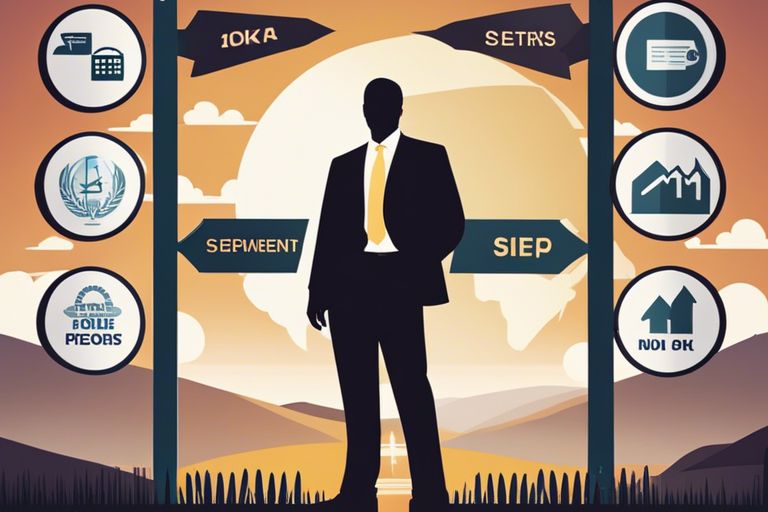Saving for retirement is a crucial aspect of financial planning, yet for entrepreneurs without the traditional employer-sponsored plans, it can present unique challenges. Navigating the self-employed landscape requires a strategic approach to building retirement savings that align with the fluctuating income and responsibilities of running a business. In this blog post, we will provide tailored advice for entrepreneurs on how to effectively save for retirement without relying on typical employer-sponsored plans.
Key Takeaways:
- Establish a retirement account: Set up a Individual Retirement Account (IRA) or a Simplified Employee Pension (SEP) plan to start saving for retirement independently.
- Maximize contributions: Contribute as much as possible to your retirement account each year to take advantage of tax benefits and build your nest egg.
- Automate savings: Set up automatic transfers from your business account to your retirement account to ensure consistent savings without hassle.
- Diversify investments: Spread your retirement savings across a mix of investments, such as stocks, bonds, and real estate, to minimize risk and maximize returns.
- Seek professional advice: Consult with a financial advisor or retirement planner to tailor a retirement savings strategy that aligns with your entrepreneurial goals and financial situation.
Understanding Retirement Savings Options
Now, as an entrepreneur navigating the self-employed landscape, it’s crucial to explore various retirement savings options to secure your financial future. For detailed insights on retirement plans tailored for self-employed individuals, check out Retirement Plan Considerations for the Self-Employed.
Traditional IRA: Basics and Benefits
Benefits: A Traditional IRA offers tax-deferred growth on your savings until withdrawal during retirement. As an entrepreneur, contributing to a Traditional IRA can reduce your taxable income while building a nest egg for the future.
Roth IRA: Understanding the Tax Advantages
Understanding: A Roth IRA provides tax-free withdrawals in retirement, making it an attractive option for entrepreneurs expecting to be in a higher tax bracket later in life. Additionally, contributions to a Roth IRA can be withdrawn penalty-free, providing flexibility in emergencies.
For entrepreneurs looking for a retirement savings solution that allows for higher contribution limits and potential tax savings, consider the SEP IRA.
SEP IRA: Simplified Employee Pension Plans for Entrepreneurs
For entrepreneurs with fluctuating incomes or those seeking a retirement plan that allows for higher contribution limits, the SEP IRA can be a valuable option. With potential tax benefits and simplified administration, the SEP IRA is designed to cater to the unique needs of self-employed individuals.
To optimize retirement savings for solo entrepreneurs with no employees, the Solo 401(k) offers flexibility and potential tax advantages.
Solo 401(k): A Flexible Option for Solo Entrepreneurs
Entrepreneurs: The Solo 401(k) allows for both employee and employer contributions, enabling solo entrepreneurs to save more for retirement compared to other retirement plans. With the ability to make larger contributions as both the employer and employee, the Solo 401(k) is a powerful tool for building retirement savings.
Evaluating Business Structures and Their Impact on Retirement
Sole Proprietorships and Retirement Planning
Retirement planning for entrepreneurs can be complex, especially for those operating as sole proprietors. Without the traditional employer-sponsored plans like 401(k)s, it is crucial for sole proprietors to set up their own retirement savings strategies. One option commonly utilized by sole proprietors is the Simplified Employee Pension (SEP) IRA, which allows for substantial contributions that are tax-deductible. By contributing a percentage of their business profits to a SEP IRA, sole proprietors can build a significant retirement nest egg while enjoying the tax benefits associated with it.
The Implications of Incorporating on Retirement Savings
In the context of retirement savings, the decision to incorporate can have far-reaching implications for entrepreneurs. By incorporating their business, entrepreneurs can establish retirement plans such as a Solo 401(k) or a Defined Benefit Plan, which offer higher contribution limits and additional tax advantages. Incorporating also provides a level of liability protection that can help safeguard retirement savings from potential business risks. It’s important for entrepreneurs to carefully evaluate the impact of incorporating on their retirement savings and consult with financial experts to determine the most suitable retirement plan for their needs.
Tax Planning for Retirement Contributions
Despite not having access to traditional employer-sponsored retirement plans, entrepreneurs can still take advantage of tax-deferred growth and potential deductions by contributing to individual retirement accounts (IRAs) and other retirement savings vehicles. By strategically planning retirement contributions, entrepreneurs can minimize their tax liability while building a solid financial foundation for their future.
Maximizing Deductions through Retirement Contributions
Retirement contributions serve as a valuable tool for reducing taxable income while simultaneously saving for the future. For self-employed individuals, options such as a Simplified Employee Pension (SEP) IRA or a solo 401(k) can offer generous contribution limits, allowing entrepreneurs to maximize deductions and build a substantial retirement nest egg. By carefully considering contribution amounts and timing, entrepreneurs can optimize their tax savings and set themselves up for long-term financial security.
Strategies for Tax-Efficient Withdrawals in Retirement
Retirement planning doesn’t end with making contributions – entrepreneurs must also consider tax-efficient withdrawal strategies to make the most of their retirement savings. By diversifying retirement accounts and strategically timing withdrawals, entrepreneurs can minimize the tax impact of tapping into their savings during retirement. Utilizing a combination of taxable, tax-deferred, and tax-free accounts can further optimize tax efficiency, ensuring that entrepreneurs can enjoy a comfortable retirement without sacrificing unnecessary funds to taxes.

Incorporating Your Business into Your Retirement Plan
Not having access to traditional employer-sponsored retirement plans does not mean that entrepreneurs cannot build a solid retirement savings strategy. One way to do this is by incorporating your business into your retirement plan. By leveraging the assets and value of your business, you can create a unique retirement funding opportunity tailored to your entrepreneurial journey.
Using a Business Exit Strategy to Fund Retirement
Business exit strategies can be a powerful tool for entrepreneurs looking to fund their retirement. By strategically planning and executing the sale or transition of your business, you can unlock a significant amount of capital that can be used to bolster your retirement savings. Whether through a merger, acquisition, or selling shares of your company, your business can play a crucial role in securing your financial future.
Valuing Your Business as a Retirement Asset
With a substantial portion of an entrepreneur’s wealth tied up in their business, it is crucial to accurately value your business as a retirement asset. Understanding the worth of your business can help you make informed decisions about how to incorporate it into your retirement plan. Whether through professional valuation services or using financial metrics and industry benchmarks, knowing the value of your business is key to maximizing its potential as a retirement asset.
Investment Strategies for Self-Directed Retirement Accounts
Diversifying Your Investment Portfolio
To build a solid retirement savings without traditional employer-sponsored plans, entrepreneurs should consider diversifying their investment portfolio. Your self-directed retirement account gives you the flexibility to invest in a wide range of assets beyond the typical stocks and bonds. Diversification helps spread risk and can enhance long-term returns, providing a cushion against market fluctuations. Consider allocating your funds across various asset classes such as real estate, commodities, or alternative investments to mitigate risk and maximize growth potential.
Understanding Risk Management for Long-Term Growth
On the journey to building retirement savings, understanding risk management is crucial for achieving long-term growth. Properly assessing and managing risk in your investment decisions can lead to a more stable and profitable retirement portfolio. Consider your risk tolerance, time horizon, and financial goals when making investment choices. By balancing risk and return, you can optimize your investment strategy for sustainable growth over the years. Accounts.

Insurance and Retirement for Entrepreneurs
The Role of Life Insurance in Retirement Planning
All entrepreneurs should consider incorporating life insurance into their retirement planning strategy. Life insurance can provide a financial safety net for your loved ones in the event of your passing, ensuring they are taken care of even without a traditional employer-sponsored plan. Additionally, some life insurance policies offer cash value accumulation, which can be used as a source of retirement income. For more detailed information on retirement planning options for the self-employed, check out Retirement Planning for the Self-Employed: 5 Options ….
Disability Insurance: Protecting Your Income Pre-Retirement
Any entrepreneur should seriously consider investing in disability insurance to protect their income pre-retirement. Disability insurance can provide a source of income if you become unable to work due to illness or injury, ensuring your finances remain stable during challenging times. According to statistics, entrepreneurs are more likely to face income fluctuations, making disability insurance an vital component of a comprehensive retirement savings plan.
With disability insurance, you can safeguard your income and continue building your retirement savings even if you are unable to work for a period of time. This type of insurance provides peace of mind and financial security in unpredictable circumstances, allowing you to focus on growing your business without the fear of losing your income.
Another important consideration for entrepreneurs is to regularly review and update your insurance policies to ensure they align with your current financial and business needs. By staying proactive and informed about your insurance options, you can better protect your income and retirement savings as a self-employed individual.
Building a Retirement Savings Timeline
For entrepreneurs without traditional employer-sponsored retirement plans, saving for retirement can be a more complex process. The good news is that there are several options available to self-employed individuals. To learn more about how to save for retirement as a sole proprietor, check out this helpful resource from AARP.
Setting Milestones for Retirement Savings Goals
Milestones play a crucial role in achieving any long-term financial goal, including retirement savings. By setting specific targets at different stages of your entrepreneurial journey, you can track your progress and stay motivated. Start by establishing short-term and long-term savings goals, such as how much you aim to save each month and your desired retirement age. Regularly revisiting and adjusting these milestones is key to staying on track and adapting to any changes in your financial situation.
Adjusting Your Strategy as Your Business and Personal Life Evolve
Retirement planning is not a one-time task; it requires ongoing monitoring and adjustments. As your business grows and your personal life circumstances change, it’s vital to reassess your retirement savings strategy. Factors such as fluctuations in income, new business opportunities, or unexpected expenses can impact your savings plan. Regularly reviewing your financial goals and adapting your strategy accordingly will help ensure you’re on the right path towards a secure retirement.


Summing up
Presently, entrepreneurs have more options than ever when it comes to building their retirement savings without relying on traditional employer-sponsored plans. By taking advantage of tax-advantaged accounts like SEP-IRAs, Solo 401(k)s, or Roth IRAs, self-employed individuals can ensure they have a solid financial cushion for their golden years. Additionally, implementing simple yet effective strategies such as consistently contributing a percentage of income to retirement accounts, diversifying investments, and seeking professional advice can help entrepreneurs achieve their retirement goals and secure their financial future.




